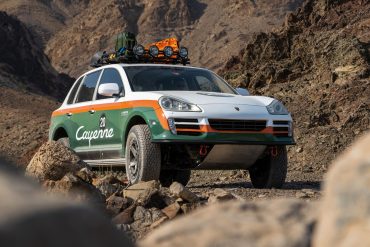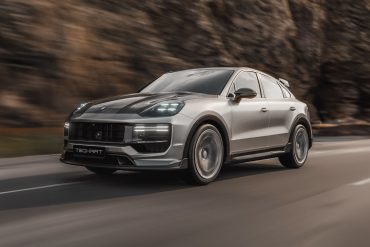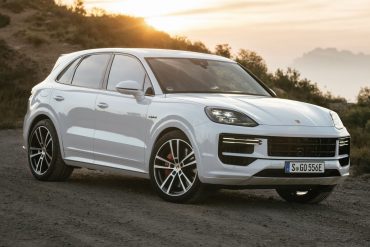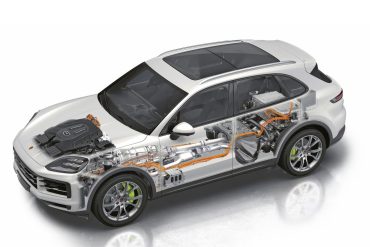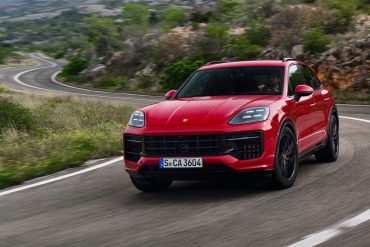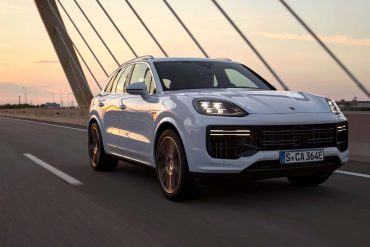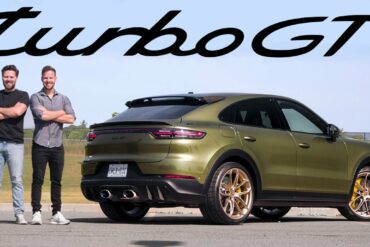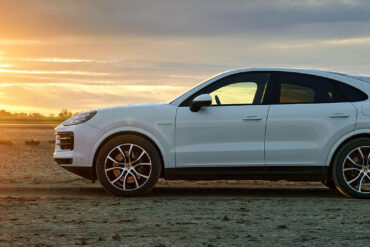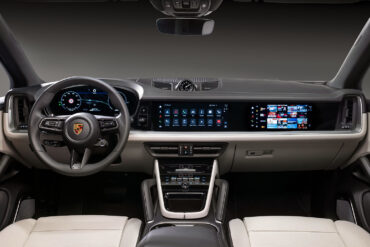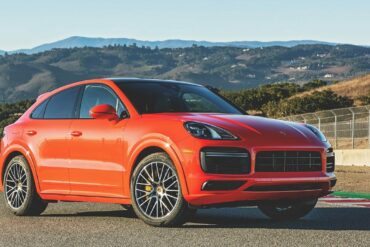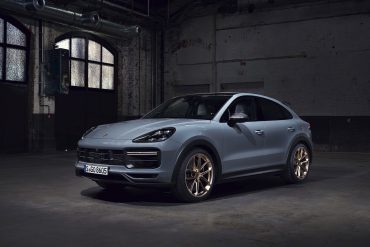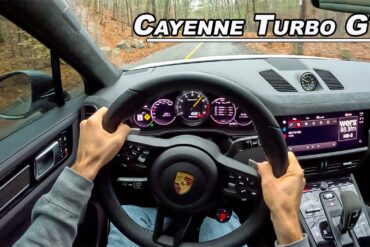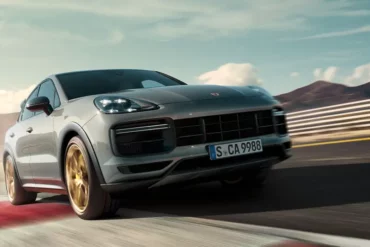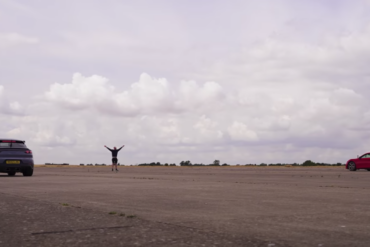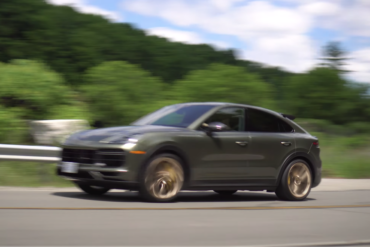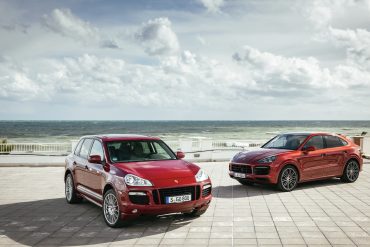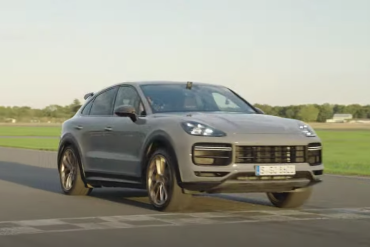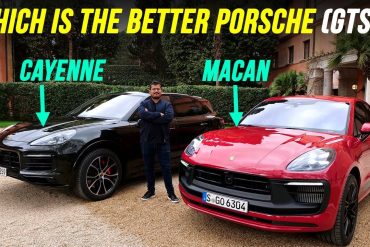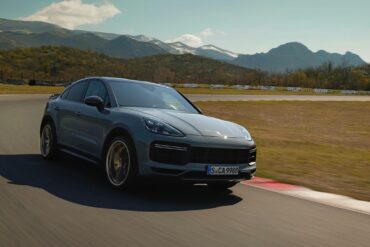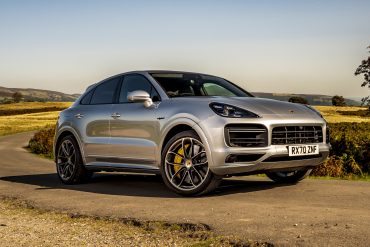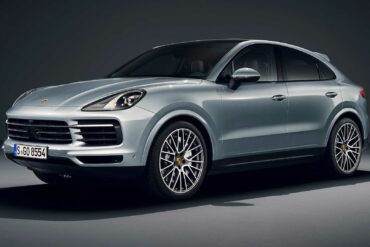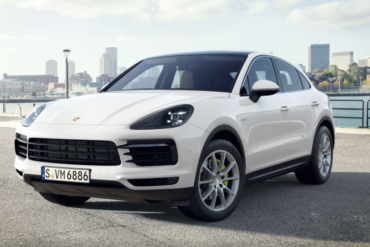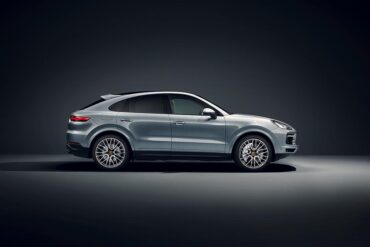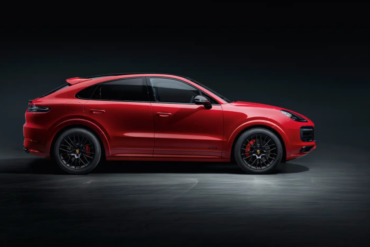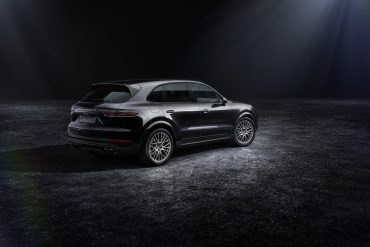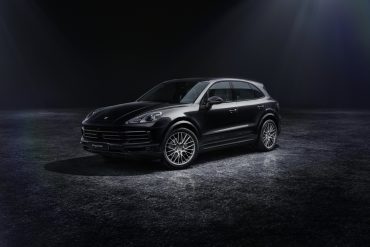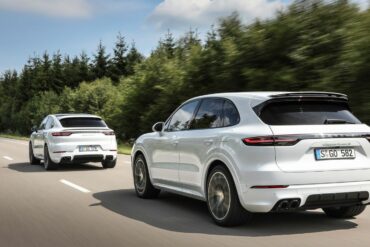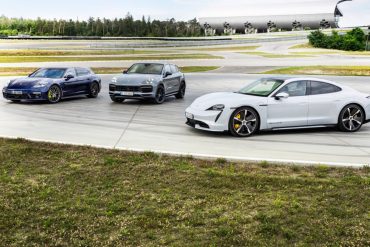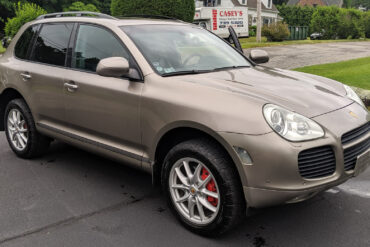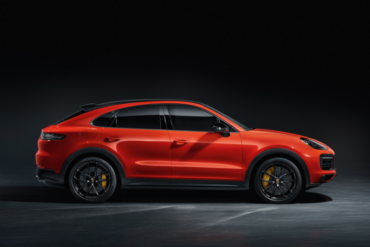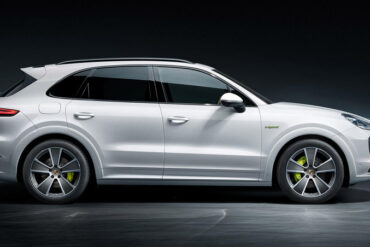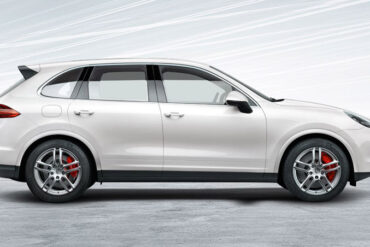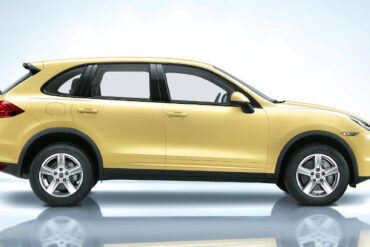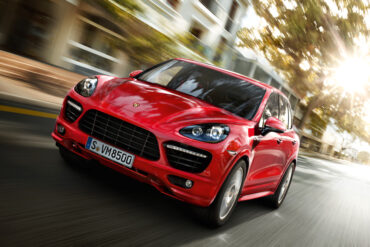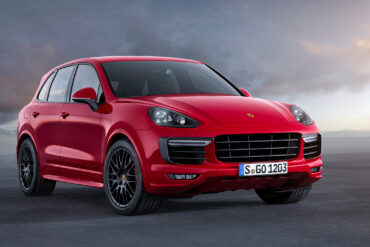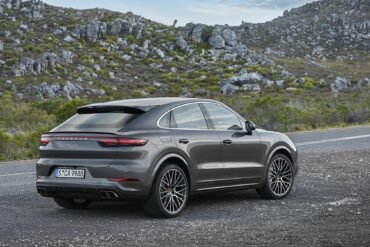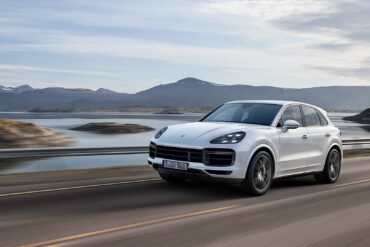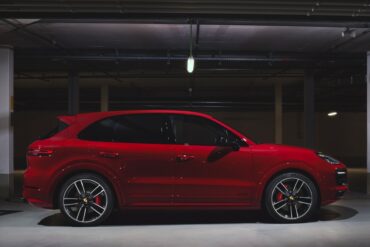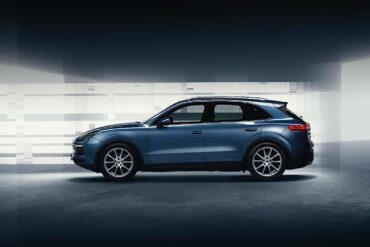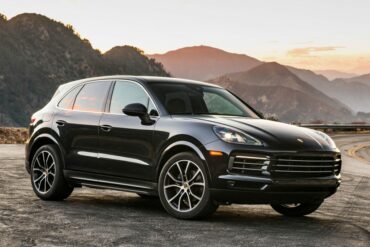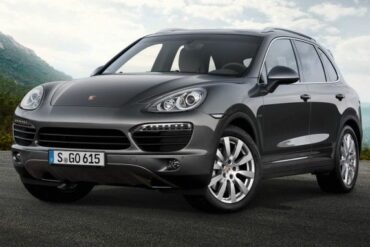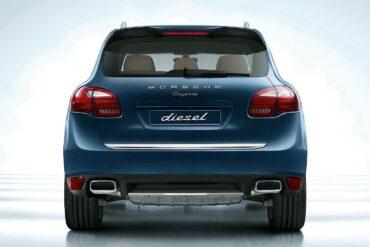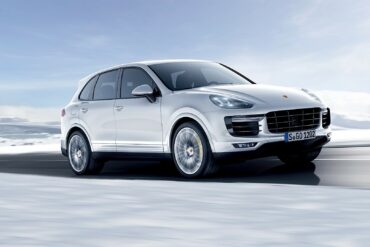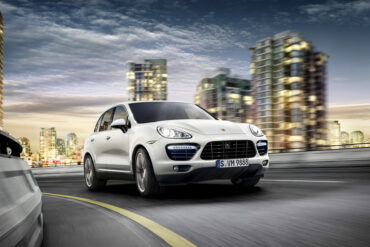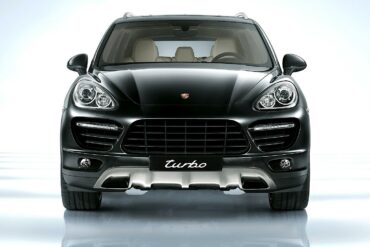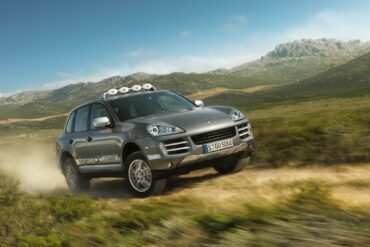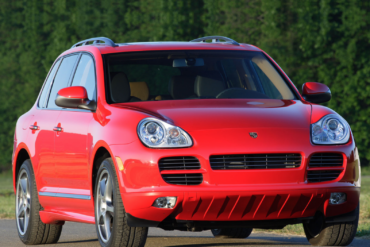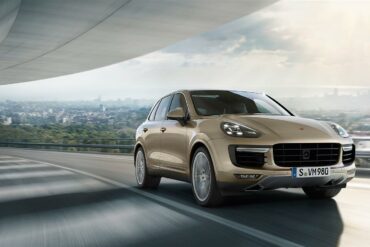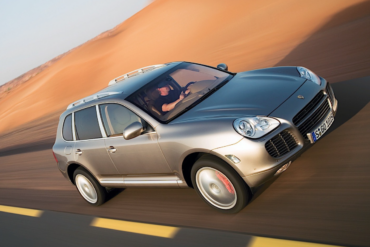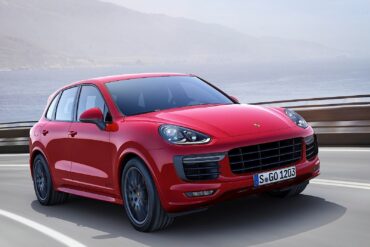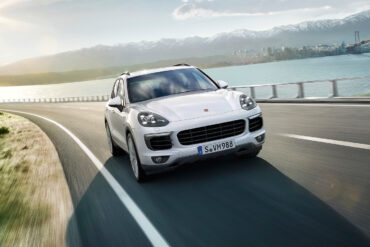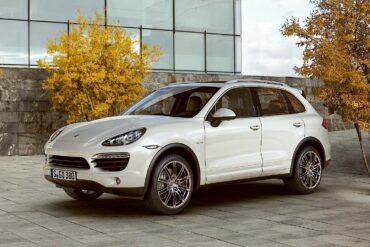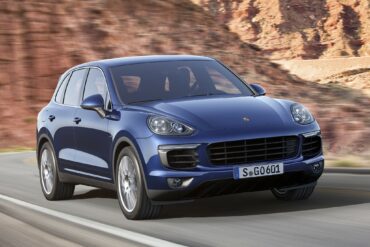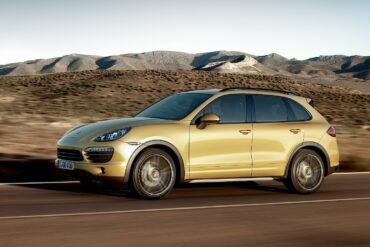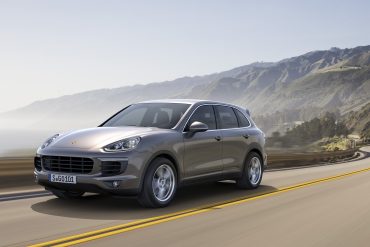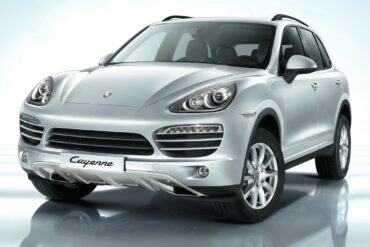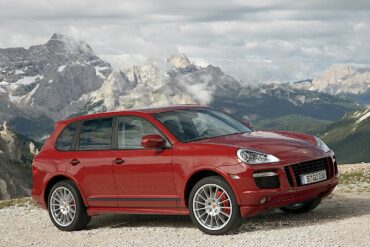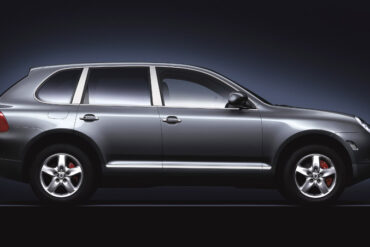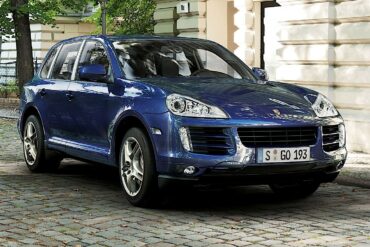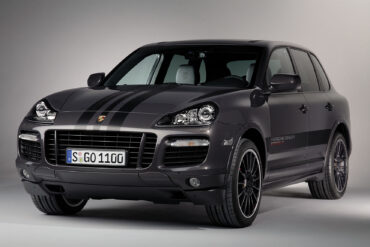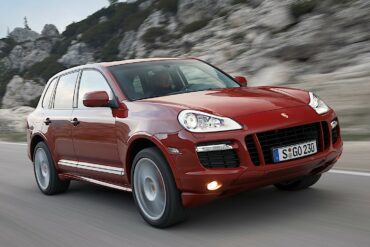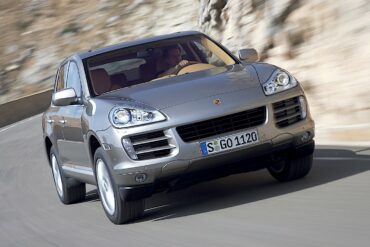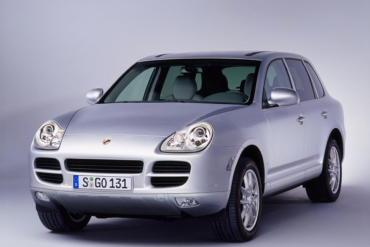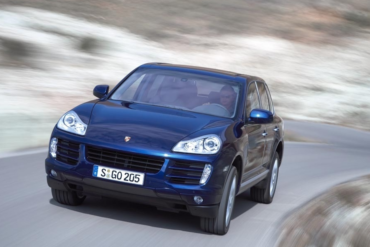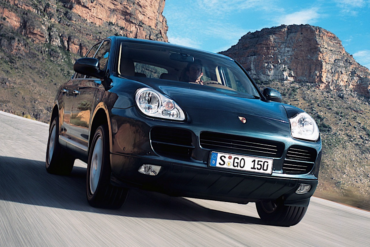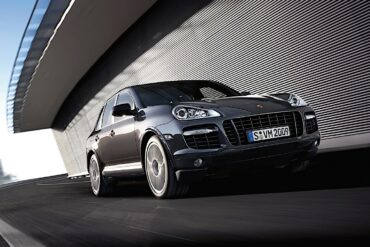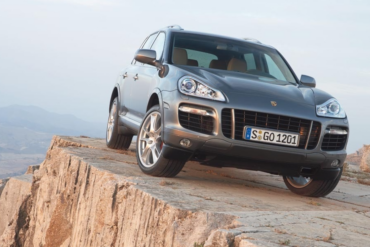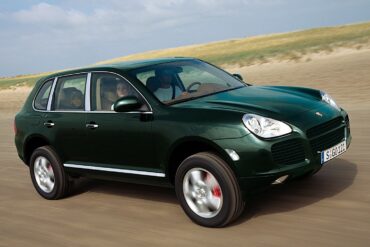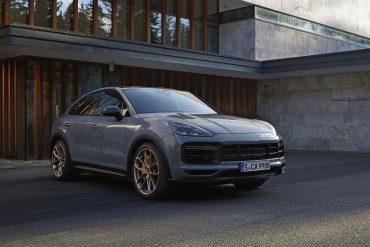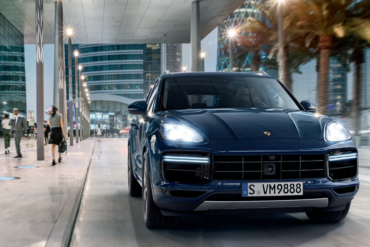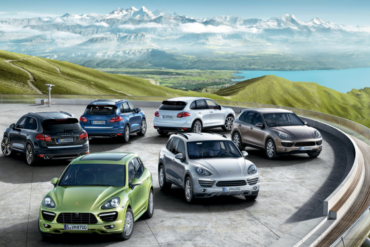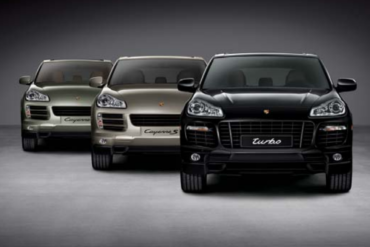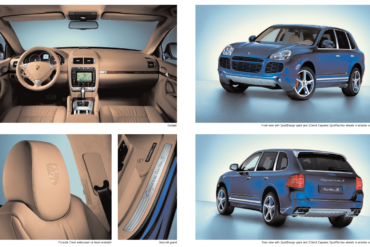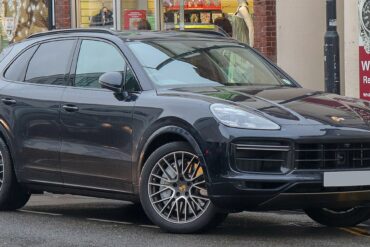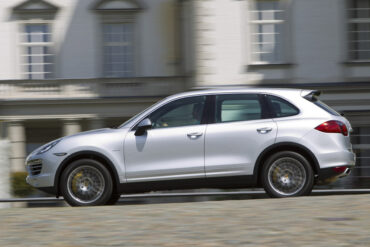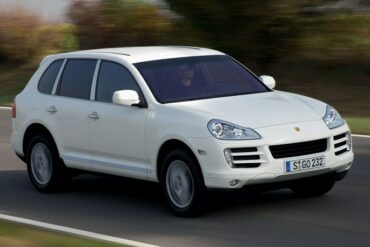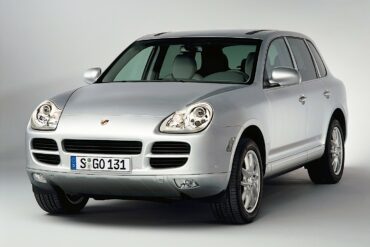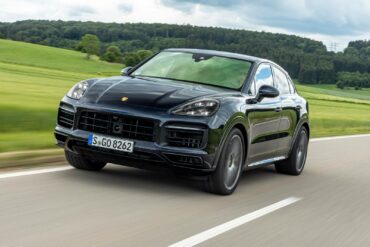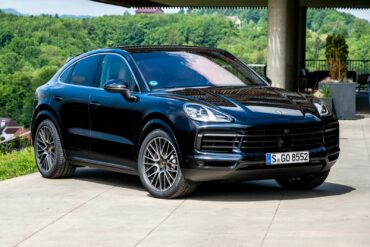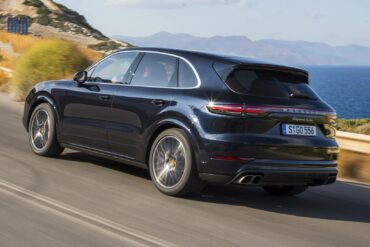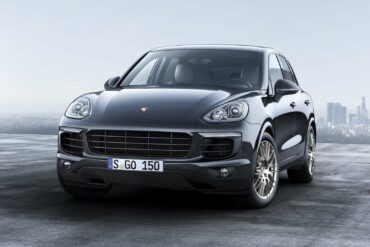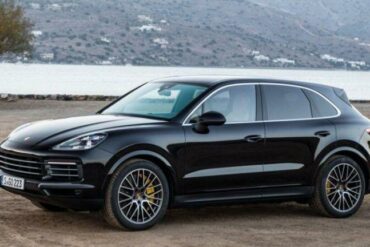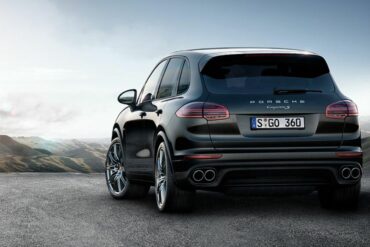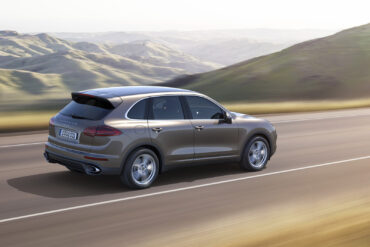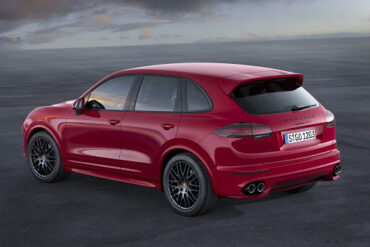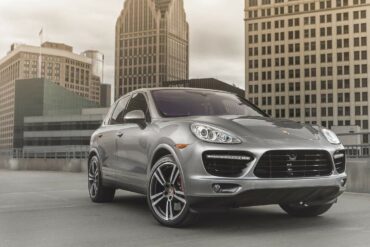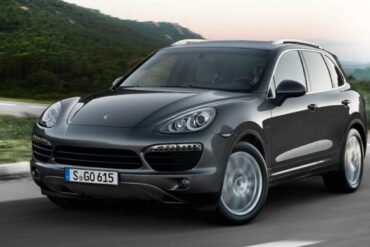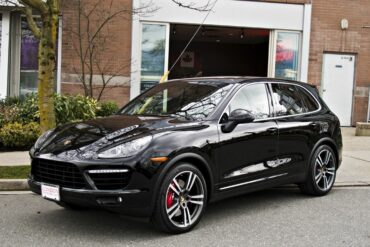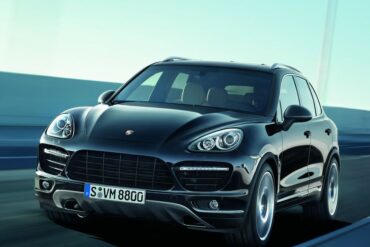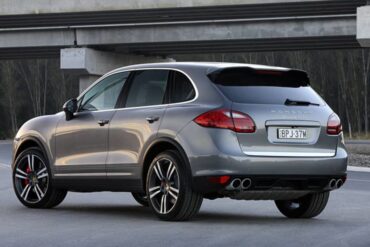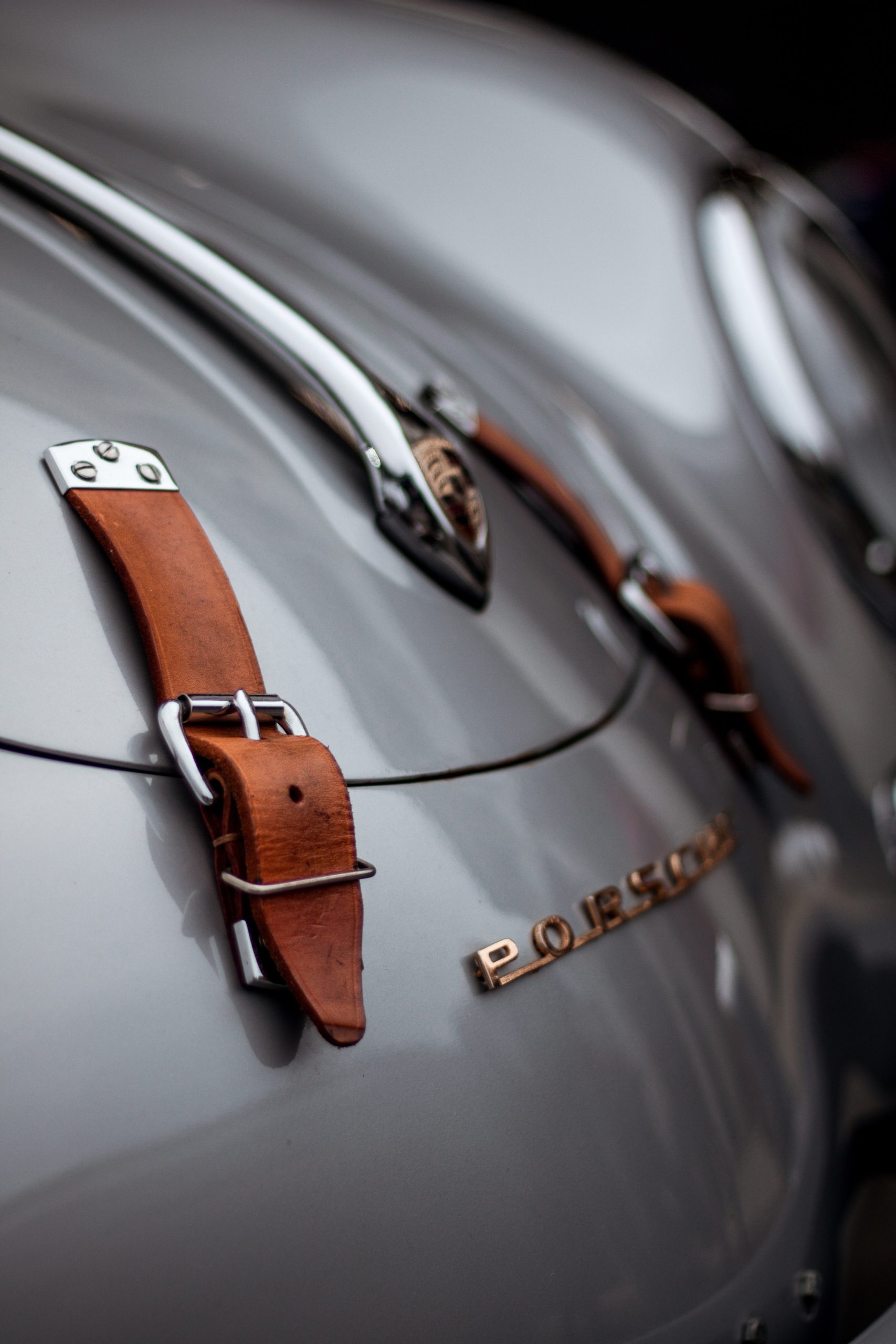Over twenty years after its launch, the first-generation Porsche Cayenne has had new life breathed into it as part of...
315 results for
Cayenne
Individuality and performance redefined: The TECHART Aero Kit I for all Porsche Cayenne facelift models E3.2 is here. For all...
For more than twenty years, the Cayenne has been characterized by its ability to provide a broad range of qualities:...
The new Porsche Cayenne, a superb example of leading-edge software integration, owes its performance and customer experience to the expertise...
For the 2025 model year, a number of new standard features and options are being introduced for the Cayenne model...
At Porsche, the “GTS” designation—short for Gran Turismo Sport—signifies enhanced dynamism and long-distance performance. The Cayenne fundamentally embodies the dual...
After the successful launch of the new Cayenne in early 2023, Porsche is topping off the comprehensively revised third generation...
Starting at $190,150 in the US and $214,780 in Canada, the 2022 Porsche Cayenne Turbo GT is a powerful SUV...
Porsche has fundamentally overhauled the third generation of the Cayenne with comprehensive changes to the powertrain, chassis, design and equipment....
New Porsche Driver Experience makes its debut in the Cayenne Porsche presents a completely new, innovative architecture for the interior...
Prepare for a showdown between two vehicles that will surely pique your interest! The contenders are a Porsche Cayenne and...
A 2020 Porsche Cayenne Turbo Coupe complete a full lap around Laguna Seca in 1 minute and 40.3 seconds with...
The all-new Cayenne Turbo GT, introduced for the 2022 model year, packs a fearsome punch that rivals will find hard to...
The all-new Cayenne Turbo GT, introduced for the 2022 model year, packs a fearsome punch that rivals will find hard to...
The all-new Cayenne Turbo GT, introduced for the 2022 model year, packs a fearsome punch that rivals will find hard to...
2023 Porsche Cayenne Variants, Reviews, Pricing, and Specs Prices Starting at $73,650 Overview Revealed online on August 29, 2017, the...
2023 Porsche 911 Dakar Announced The latest 911 model variant proves its mettle where the pavement ends Atlanta. Porsche is celebrating...
The Porsche Cayenne Turbo GT Coupe is the fastest SUV to go around the Nurburgring and one of the fastest...
Who’s ready for an SUV v supercar drag race?! We’ve got Mat lining up in the incredible Porsche Cayenne Turbo GT,...
Ultimate Review & Comparison – Cayenne Turbo GT v Aston Martin DBX 707 Which is the best high-performance SUV (that...
Below is a really thorough review of the 2022 Porsche Cayenne Turbo GT by The Straight Pipes team. The Turbo...
Fourteen years before the Cayenne was introduced, Ferry Porsche made a statement that seemed to have foretold of the Cayenne,...
Sub-four-second 0-60s and 600bhp are performance figures that were once exclusively the domain of supercars, but not these days… In...
For those in the market for a people mover and some fun at the same time, the Macan GTS and...
The Cayenne Turbo S E-Hybrid models, mix ultimate performance with comfort and Infotainment. The twin-turbo V8 engine and electric motor combination make it an absolute monster. So much so, that it became top dog in the Porsche SUV lineup, relegating the 541-hp Cayenne Turbo to second place. This is an SUV that has the price, prestige, and performance. Generating 670 combined horsepower and 633 lb-ft of torque.
Porsche is stuffing a built twin-turbocharged 4.0-liter into the Cayenne Coupe, and it's the most powerful V-8 the German automaker has ever produced. It makes 631 horsepower in this new Turbo GT model, and Porsche says its factory driver Lars Kern set a new SUV lap record at the Nürburgring Nordschleife in it lapping the 12.9-mile course in 7:38.9. The new Cayenne will arrive in the U.S, only in Coupe form, next year starting at $182,150.
The Cayenne Turbo S E-Hybrid Coupe mixes ultimate performance with comfort and Infotainment. The Turbo GT has all the attributes to be ahead of the game from the start. The twin-turbo V8 engine and electric motor combination make it an absolute monster. So much so, that it became top dog in the Porsche SUV lineup, relegating the 541-hp Cayenne Turbo to second place. This is an SUV that has the price, prestige, and performance, but it is the Coupe that has the looks. Generating 670 combined horsepower and 633 lb-ft of torque.
The 434-hp Cayenne S goes from 0 - 60 mph in just 4.2 seconds, same as the SUV. In fact, the Coupe and SUV share everything from engines to suspension components to interior trimmings and onboard tech, with only a sloping roofline setting them apart. Our advice. If you want less practicality with a cool fastback roofline, the Porsche Cayenne S coupe is a more stylish version of the Cayenne S. A great all rounder.
Porsche fitted the Cayenne E-Hybrid with a turbocharged 340 hp 3.0-liter V6 engine combined with a 136 hp electric motor for the drivetrain. Total combined power output reached 462 hp. The whole assembly was mated to an 8-speed automatic transmission that sent the power in all corners. Now it comes with a coupe body? Not sure the combination makes much sense to us, but hey this is Porsche and they know more than we do I guess.
The Cayenne Coupe is a version of Porsche's largest SUV with a heavy dose of extra swagger. Porsche introduced the new variant a year after the debut of the third-generation Cayenne, for the 2020 model year. While we like the look of the coupe, it feels out of place on the base Cayenne (which is more a family SUV choice). A nice package, but we would recommend spending a bit more and going for the Cayenne S or GTS.
Three letters are all it takes to describe the glint in your eye and intense goosebumps – GTS. Pure and thrilling: the Cayenne GTS models bring a motorsport atmosphere to the road. Enough power to strive for more freedom: with 453 hp and 457 lb.-ft. of torque, the 4.0-liter twin-turbo V8 engine exudes a drive that helps achieve your goals. The striking black accents on the front fascia, sideskirts and aerodynamic roof spoiler combined with the coupe bodystyle.
The third generation of the Porsche Cayenne was unveiled in August 2017. In 2022, the Cayenne added the Platinum Edition to the SUV and coupe body styles. The Platinum Edition Cayenne applies a coat of Satin Platinum paint to a number of the vehicle's badges, as well as its fascia-mounted intake treatment and its distinct 21-inch wheels. Black exhaust tips and window trim add an extra hint of menace to the model.
2022 Porsche Cayenne Variants, Reviews, Pricing, and Specs Prices Starting at $70,350 Overview Revealed online on August 29, 2017, the...
Porsche Cayenne Sales Figures Porsche Cayenne Sales Numbers (U.S Market) Sales Totals Per Year & Model (coming soon) Sales...
More Porsche owners now have the opportunity to record their lap times and hone their race craft on more than...
2002-2006 Porsche Cayenne Service Schedule This maintenance service schedule checklist is ONLY for the following Porsche models and years: 2002,...
Porsche Cayenne (3rd Generation) The Ultimate Model Guide Porsche Cayenne (9YA) (2017 – Present) The Story / Model Guides / Misc Data / News & Updates...
3rd Generation Porsche Cayenne (9YA) Story & History Cayenne (2019 – Present) Date of unveil by Porsche AG: 2017 August...
2nd Generation Porsche Cayenne (958.2) Story & History Cayenne (2015 – 2018) Date of unveil by Porsche AG: 2014 July...
2nd Generation Porsche Cayenne (958.1) Story & History Cayenne (2010 – 2014) Date of unveil by Porsche AG: 2010 February...
The Cayenne GTS is the hair-splitter’s latest achievement. It’s a Cayenne powered by the same 4.8-liter V-8 as seen in the Cayenne S but tuned for an additional 20 horsepower and 11 pound-feet of torque to make 420/380. It wears a body similar in style to the Cayenne Turbo, meaning a domed hood, blacked-out trim, and body-color fender extensions and side skirts. And it’s loaded with standard performance gear that is optional on lesser Cayennes. What isn't there to like?
Porsche Cayenne (2nd Generation) The Ultimate Model Guide Porsche Cayenne (958.1/958.2) (2010 – 2017) 958.1 Story / 958.1 Timeline / 958.1 Model Guides / 958.2 Story / 958.2...
Car and Driver said "It isn't really a coupe, but this 541-hp fastback SUV is the same awesome Cayenne Turbo underneath—with a sexier backside". We agree. Here's what you need to know. With its 541-hp twin-turbo 4.0-liter V-8, eight-speed automatic transmission, and all-wheel drive, the new fastback version of Porsche's largest SUV is mechanically identical to the conventional Cayenne Turbo SUV, and the two vehicles feel exactly the same from behind the wheel.
Its top model was the Cayenne Turbo, with 550 hp under the hood. The third generation came to fix what its predecessor was criticized for: the exterior design. While the second generation featured some details that could remind of a Hyundai, the third generation was completely new from tip to toe. Under the hood, the Cayenne Turbo featured a 4.0-liter V8 unit with two turbochargers. It was mated as standard to an eight-speed automatic transmission.
The V8 is back in the Cayenne GTS after a break for the second generation (it got a twin-turbo V6). The Cayenne GTS is now also available in the new "Coupe" body style. A twin-turbocharged 4.0-liter V8 is good for 453 horsepower and 457 lb-ft of torque. Zero to 60 mph takes a claimed 4.2 seconds if the Sport Chrono package is fitted, and top speed rises to 168 mph. he only transmission available is an eight-speed automatic. This is one sweet ride.
The 434-hp Cayenne S goes from 0 - 60 mph in just 4.2 seconds. Its twin-turbocharged 2.9-liter V-6 helps it to crush the quarter-mile in just 12.8 seconds. Perhaps even more impressive is that the on the optional 21-inch Pirelli P Zero summer tires, the Porsche has a 0.93 g of cornering grip. This is basically a sports car in an SUV body. The Cayenne's dynamic excellence is unmatched in the segment. Easily the best SUV on sale today.
The E-Hybrid version of the current Cayenne came in 2018. Porsche used the same platform as the Bentley Bentayga and the Lamborghini Urus for the third generation of the Cayenne. This platform was designed from the beginning to accept a hybrid version. It also featured a rear-axle steering system which really helps with low speed turning and cornering at speed.
The third generation of the Porsche Cayenne was unveiled in August 2017. The third generation Cayenne is built on a totally new platform, shared with SUVs like the Bentley Bentayga and Lamborghini Urus. It was fitted with important technical upgrades, such as the rear-axle steering system, which allowed a better cornering speed and an easier parking maneuver.
The Cayenne S diesel earns the “S” by way of a twin-turbocharged 4.2-liter diesel V-8 engine that pumps out a prodigious 382 hp and 627 lb-ft of torque. By comparison, the non-S Cayenne diesel’s 3.0-liter V-6 spits out a relatively puny 240 hp and 406 lb-ft of twist. Interestingly, the S diesel gets Porsche’s engine stop-start system standard; here in the U.S., the fuel-saving feature isn’t available on the pedestrian Cayenne diesel.
The Cayenne S diesel earns the “S” by way of a twin-turbocharged 4.2-liter diesel V-8 engine that pumps out a prodigious 382 hp and 627 lb-ft of torque. By comparison, the non-S Cayenne diesel’s 3.0-liter V-6 spits out a relatively puny 240 hp and 406 lb-ft of twist. Interestingly, the S diesel gets Porsche’s engine stop-start system standard; here in the U.S., the fuel-saving feature isn’t available on the pedestrian Cayenne diesel.
The facelifted version of the Porsche Cayenne was introduced in 2014 and it received a restyled design, new features, and, most important, upgraded engines, such as the V6 diesel version. The V6 diesel version played an important role in this and Porsche decided to keep it in the stable. Along with the facelifted version of the second generation Cayenne, a new V6 diesel was installed. Under the hood, the 2014 Cayenne Diesel offered an enhanced version of the 3.0-liter V6 diesel unit.
The V6 diesel engine was the same unit found in the other Volkswagen group models. The 3.0-liter unit offered 240 hp. It was mated as standard with an 8-speed automatic gearbox. Cayenne Diesel Turbo 3.0 176 kW for 2011 model year. In 2012, power increased to 180 kW. 2013 saw the launch of the Cayenne Diesel S Turbo 4.1 281 kW version. The Cayenne Diesel with its 240 bhp is hardly a top performer.
The Turbo S version was the sportiest version for the second generation of the Porsche Cayenne and, along with the rest of the stable, it received a facelift for the 2015 model year. The revised engine offered 20 hp more than its predecessor. It was the same twin-turbo 4.8-liter V8 unit and it was paired to an 8-speed auto and like the Turbo, it was offered with a standard air-suspension but adds Ceramic Brakes system.
As the flagship of the Cayenne army, the Turbo S was well received by those who were looking for a faster SUV. And it wasn't only the speed, but also the cornering speed that the Turbo S was capable of. The engine was based on the 4.8-liter V8 unit installed in the Cayenne S and Cayenne Turbo, but with a higher compression ratio that led to 50 more hp. The standard transmission was an 8-speed Tiptronic S.
The second generation of the Porsche Cayenne was launched at the 2010 Geneva Motor Show. It was a big improvement over its predecessor and featured an evolved design. For the engine, the Cayenne Turbo featured a 4.8-liter V8 unit which offered 500 hp. For the transmission, the 2010 Cayenne lost the low-range transfer case. The standard transmission was an 8-speed Tiptronic gearbox. All-wheel drive was installed standard as well. Other new improvements led to a decrease in the overall weight by 180 kg (400 lbs).
Named after the 7200km intercontinental rally which the Cayenne won in 2007, the Porsche Cayenne S Transsyberia Special Edition offers a number of enhancements. It takes the 4.8-liter V8 unit that develops 405bhp and 500Nm of torque from the range topping GTS allowing the model to drop its base 0-60 mph time down by 0.5 seconds to 6.1 seconds. It is mated to a six-speed manual gearbox (automticac optional), with a 4.1:1 drive ratio and air suspension coupled with PASM.
The Cayenne S Titanium Edition was designed specifically for the U.S. and Canadian markets. Introduced only for 2006 (as a pre-GTS concept), it was a 1 year exclusive, limited production SUV featuring a lightweight steel body, aluminium hood, titanium-painted accented body parts, side lower rocker body panels, Sport-Quad Tip Exhaust chrome tailpipes, 19" titanium painted alloy wheels, bi-xenon headlights, two-tone interior upholstery, Porsche PCM 2.0 w/ trip computer navigation, MP3 audio and Bose cabin surround sound.
The Cayenne Turbo facelift was introduced in 2014 as a 2015 MY. Think of it as an enhanced version of the non-facelifted version. It offered the same torque as the non-facelifted Cayenne Turbo S, but less power. Under the hood, the revised engine offered 20 hp more than its predecessor. The exterior of the 2015 Cayenne was enhanced with a sharper design and clear lines. The front fenders, the grille, and the headlights were entirely new, with LEDs.
Porsche made things more interesting with the launch of a Turbo S version in 2006 to compete with the Mercedes-Benz ML 63 AMG. The Turbo S is powered by a twin-turbocharged 4.5 L V8 that produces 521 PS (383 kW; 514 hp) and 720 N⋅m (530 lb⋅ft) of torque; Acceleration from 0–60 mph (97 km/h) takes 5.0 seconds and the top speed is 171 mph (275 km/h); It features a six-speed automatic Tiptronic transmission.
For the 2015 facelift, the Cayenne GTS was improved in every way, offering better performances and lower fuel consumption. But unlike the rest of the range, it offered a sportier look. That side was reserved for the GTS, which took its badge from the 1963 Porsche 904 GTS. It was the first Porsche to revive that acronym.
The exterior of the 2014 Cayenne Hybrid was slightly different than the rest of the range. From the 4-LED daytime running lights and the green brake calipers to the special light-alloy wheels. The rear roof-spoiler was standard as well. Unusual though, even if the German SUV was a plug-in hybrid, it featured four round exhausts. The engine was a 3.0-liter supercharged V6 which offered 333 hp. It was helped by a 95 hp electric motor.
The absolute highlight of this new generation is the world debut of the Cayenne S Hybrid with its technically highly sophisticated parallel full hybrid drive and fuel consumption in the New European Driving Cycle of just 8.2 litres/100 kilometres (equal to 34.4 mpg imp), which means CO2 emissions of just 193 g/km. The Cayenne S Hybrid therefore combines the performance of an eight-cylinder with the economy of a six-cylinder running on much less fuel.
The Cayenne S gains V-6 power during its midcycle update. Porsche advertises more power und more efficiency—the new motor is up 20 horsepower to 420. Torque is a healthy 406 lb-ft, but the turbo-six lacks the personality of the V-8. Which, as V-8s go, was quite nice if rather generically Teutonic. Like, perhaps the iron-fisted Swabian middle manager of V-8s. It keeps the 8-speed automatic. Porsche claims that it has made interior revisions, but the innards look pretty much the same to us, save for the new steering wheel.
Car and Driver said:' "More horsepower and less weight add up to a winning combo in the Cayenne S". We agree. Alongside the weight loss and the striking new exterior and interior design, Porsche got an extra 15 hp from the Cayenne S’s naturally aspirated 4.8-liter V-8. A new transmission with two more forward ratios (now an 8-speed) transforms the drive. Cayenne S hits 60 mph in 5.5 seconds and clear the quarter-mile in 14.1 at 101 mph.
In July 2014, Porsche launched a facelifted Cayenne range for the 2015 model year. Minor exterior alterations and new power-train options. For the base Cayenne, there was a a mildly revised exterior and interior inspired by the 918 Spyder. Two new interior colors, Carrara White and Palladium Metallic, are new while the two-tone black/beige upholstery is now a no cost option. Dark walnut is also a new addition to the available interior accents. The suspension on all Cayennes has also been revised.
The second-generation Cayenne moved the game on for SUVs. It has a nicer design, more powerful engines and much nicer interiors. The base V6 Cayenne was good for 299 hp @ 6,300 rpm and 295 ft lbs of torque. Acceleration was decently brisk with 0 - 60 mph over in 7.5 seconds and top speed of 143 mph. The car was slightly longer, wider, and higher than its predecessor. All new models shared the new headlight graphics with additional lights at the inside so unmistakably Porsche.
1st Generation Porsche Cayenne (957) Story & History Cayenne (2007 – 2010) Unveil of official photos: 2006 December 4 /...
1st Generation Porsche Cayenne (955) Story & History Cayenne (2002 – 2006) Unveil of official photos: 2002 March 4 /...
The European market asked for a diesel engine and the car-maker had to deliver it to keep the sale up in a struggled market affected by the world financial crisis. The engine was a carry-over from the Audi line-up, with a variable turbocharger system and a 3.0-liter displacement. It offered 240 hp and it was tuned to offer more performance. For instance, at hard accelerations, the system disengaged the AC compressor until the engine reached 2500 rpm.
An exclusive limited edition Cayenne GTS “Porsche Design Edition 3”. Limited to just 1,000 units worldwide, the limited edition Cayenne adds equipment and Porsche Design styling touches to stand out from the crowd. Distinguishing the special edition model is a Lava Grey paint scheme, extended roof spoiler, racing stripes, and 21in alloy wheels in a matching anthracite finish. This special edition looks the goods, but sadly there were no mechanical changes to differentiate it from the core GTS.
The Cayenne Cayenne GTS was fitted with a 4.8-liter V8 unit, which developed 405 hp. Unlike the Turbo, it was offered with a 6-speed manual as well, while the Tiptronic S (automatic) 6-speed transmission was on the options list. This was the true enthusiasts SUV and the sweet spot in the Cayenne lineup. It also looked great with the black accents and more agressive touches throughout the exterior.
The 2008 model year marks the launch of updated Porsche Cayenne. With a striking new face that features a dramatic new headlight design and with a wide and muscular new body accented by broad wheel arches, the 2008 Porsche Cayenne's newly sculpted sheetmetal provides vivid visual testimony to the vehicle's enhanced technical features. Inside, the interior has received an important update with new infotainment unit, new gauges and more.
The first-generation Cayenne was what saved Porsche. The based Porsche Cayenne 955 entered the market to a mixed reception, although it was the performance vehicle among SUVs and had comparably good handling as well as powerful engines.[3] The lineup initially consisted of the V8-powered Cayenne S and Cayenne Turbo. Later in the model cycle, VR6 and diesel-powered versions joined the lineup. The base model is powered by a VW 3.2-L VR6 engine producing 250 PS (184 kW; 247 hp). The engine is largely the same as the VW engine.
The entire Cayenne range got a 2008 facelift. The big changes were cosmetic, with Porsche getting rid of the Porsche 996-inspired headlights and sharpening up the Cayenne S lines. A new, vertical, daytime running light appeared on the outer side of the side-scoops and the center grille was smaller. The Cayenne S started to better develop its own unique personality with the 17” light-alloy wheels fitted as standard. The Cayenne S also got cool exhausts.
The first-generation Cayenne saw the introduction of the Cayenne S in 2002. While the base Cayenne had a 3.2-L VR6 engine, the Cayenne S got a 4.5 L V8 with more power and torque. The extremely short and compact normal-aspirated V8 produced 340 hp and 310 lb⋅ft of torque. Acceleration for the Cayenne S is strong for an SUV, with 0–60 mph taking 6.9 seconds and the top speed being 150 mph. The Cayenne S also have some visual changes to better identify it, but was otherwise standard Cayenne fair.
The facelift for the flagship Cayenne came in 2008. The Porsche Cayenne Turbo S is the most powerful Cayenne ever built. Sharing the same essential 4.8-liter V8 engine as the Cayenne S, GTS and Turbo, the Turbo S got 550 horsepower and 553 lb.-ft. of torque. That's a ten percent increase in power and a seven percent boost in torque over the Cayenne Turbo. 0 to 60 mph is over in 4.7 seconds on its way to a track-proven top speed of 174 mph. Like the Cayenne S and Cayenne Turbo, the Turbo S comes standard with a six-speed Tiptronic S driver-shiftable automatic transmission.
The facelift for the first generation of the Cayenne was introduced in 2007. More powerful in every respect - that is how the new generation of the Porsche Cayenne entered the market. New striking face upfront on a wide and muscular body, with headlights in brand-new design, and with broader, even more powerful-looking wheel arches. The Turbo model 957, featuring a larger 4.8-L engine with 49 hp more power, 0–60 mph time of just 4.9 seconds.
Porsche Cayenne (1st Generation) The Ultimate Model Guide Porsche Cayenne (955/957) (2003 – 2010) 955 Story / 955 Timeline / 955 Model...
Porsche Cayenne The Ultimate Model Guide The SUV That Saved Porsche – The Cayenne Current Cayenne Lineup / Cayenne Generations / Every Cayenne Model...
Porsche Cayenne (Third Generation) Sales Brochures We found several Porsche sales brochure for the third generation Cayenne, which is known...
Porsche Cayenne (Second Generation) Sales Brochures We found several Porsche sales brochures for the second generation Cayenne, which is known as...
Porsche Cayenne (First Generation) Sales Brochures We found only one Porsche sales brochure for the first generation Cayenne, which is...
Porsche Cayenne (First Generation) Sales Brochures We found only one Porsche sales brochure for the first generation Cayenne, which is known...
Porsche Cayenne Spare Parts Catalogs (2018 – 2021 Model Year) These official Porsche PET Diagrams and codes for the current...
Porsche Cayenne Spare Parts Catalogs (2011 – 2018 Model Year) These official Porsche PET Diagrams and codes for the current...
Porsche Cayenne Spare Parts Catalogs (2008 – 2010 Model Year) These official Porsche PET Diagrams and codes for the current...
Porsche Cayenne Spare Parts Catalogs (2003 – 2006 Model Year) These official Porsche PET Diagrams and codes for the current...
Porsche Option Codes – Porsche Cayenne (2021 Model Year) Looking to decode your 2021 Porsche Cayenne option codes? Want to...
Porsche Option Codes – Porsche Cayenne (2020 Model Year) Looking to decode your 2020 Porsche Cayenne option codes? Want to...
Porsche Option Codes – Porsche Cayenne (2019 Model Year) Looking to decode your 2019 Porsche Cayenne option codes? Want to...
Porsche Option Codes – Porsche Cayenne (2018 Model Year) Looking to decode your 2018 Porsche Cayenne option codes? Want to...
Porsche Option Codes – Porsche Cayenne (2018 Model Year) Looking to decode your 2018 Porsche Cayenne option codes? Want to...
Porsche Option Codes – Porsche Cayenne (2017 Model Year) Looking to decode your 2017 Porsche Cayenne option codes? Want to...
Porsche Option Codes – Porsche Cayenne (2016 Model Year) Looking to decode your 2016 Porsche Cayenne option codes? Want to...
Porsche Option Codes – Porsche Cayenne (2015 Model Year) Looking to decode your 2015 Porsche Cayenne option codes? Want to...
Porsche Option Codes – Porsche Cayenne (2014 Model Year) Looking to decode your 2014 Porsche Cayenne option codes? Want to...
Porsche Option Codes – Porsche Cayenne (2013 Model Year) Looking to decode your 2013 Porsche Cayenne option codes? Want to...
Porsche Option Codes – Porsche Cayenne (2012 Model Year) Looking to decode your 2012 Porsche Cayenne option codes? Want to...
Porsche Option Codes – Porsche Cayenne (2011 Model Year) Looking to decode your 2011 Porsche Cayenne option codes? Want to...
Porsche Option Codes – Porsche Cayenne (2010 Model Year) Looking to decode your 2010 Porsche Cayenne option codes? Want to...


